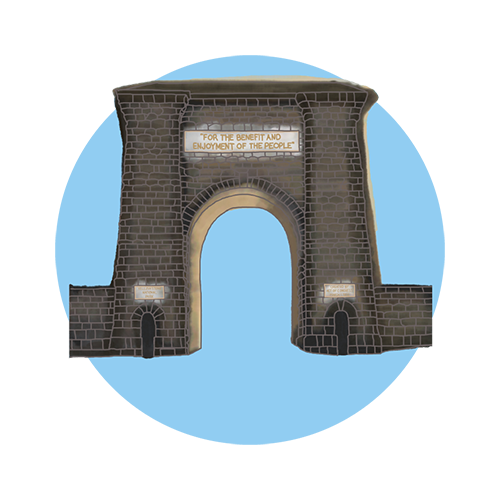The first National Park
Keywords: Assiniboine and Sioux Tribes, Blackfeet Tribe, Cheyenne River Sioux Tribe, Coeur d’Alene Tribe, Comanche Tribe of Oklahoma, Confederated Salish and Kootenai Tribes, Confederated Tribes of the Colville Indian Reservation, Confederated Tribes of the Umatilla Indian Reservation, Crow Tribe, Crow Creek Sioux Tribe, Eastern Shoshone Tribe, Flandreau Santee Sioux Tribe, Gros Ventre and Assiniboine Tribes, Kiowa Tribe of Oklahoma, Lower Brule Sioux Tribe, Nez Perce, Northern, Arapaho Tribe, Northern Cheyenne Tribe, Oglala Sioux Tribe, Rosebud Sioux Tribe, Shoshone-Bannock Tribe, Sisseton-Wahpeton Sioux Tribe, Spirit Lake Sioux Tribe
Standing Rock Sioux Tirbe, Turtle Mountain Band of the Chippewa Indians, Yankton Sioux Tribe
“There’s a lot of things that happened with how Yellowstone was founded. The original park rangers at Yellowstone were the same cavalry that were used to put us on reservations. In fact, Blackfeet people were killed to create Yellowstone Park. And then there was for decades, for about 100 years, this policy that tried to erase our connection to the land. All the while essentially trying to create this garden of Eden where they would kill all the predator species, raise the species of all the ungulates and bring in people who could get prize hunts... We see the same policies to this day in Asia, in Africa, where they’re buying these tracts of land, calling it conservation and arming them with guards and then all these policies follow the conservation model of Yellowstone...”, Big Wind says about Yellowstone.
Big Wind, among many different things, is an activist and organiser from the Northern Arapaho tribe. They were brought up on the Wind River Reservation in Wyoming where they have been leading the fight against environmental racism. They are generous with their time, welcoming us during the sun dance and their busy work schedule. Every now and then, very rarely, an innocent perhaps naïve question or a spontaneous comment elicit a thunderous laugh and broad smile from them as they patiently guide us along a steep learning curve.
We are glad to speak to Big Wind and for them to share their perspective on Yellowstone Park. Throughout our diligent sightseeing and the many visits to visitor centres, we observe a unilateral position on the way the history of the park is told.
It is famously the first National Park in the United States. It is a beacon of conservation. It is where the Bison population recovered. It is, perhaps controversially, where the wolves are back. It is wilderness.
On our second day, we enter the park from Gardiner, Montana, via the North Entrance Gate. It is also known as the Roosevelt Arch. According to Wikipedia, it is a “rusticated triumphal arch” whose “cornerstone was laid down by Theodore Roosevelt in 1903”. The arch proclaims FOR THE BENEFIT AND ENJOYMENT OF THE PEOPLE to everyone underneath it. It is a boastful quote from the Organic Act of 1872 which created Yellowstone Park. It is supposedly wilderness for everyone.
In the park though, we notice rapidly that it is NOT for everyone.
Our observant anthropological eye notices that the majority of the visitors read as white or are foreigners. Our observant anthropological mind deduces that the visitors are also of a certain socio-economic background. (like us)
However, we are most observant towards the lack of indigenous presence in the park.
At Fort Yellowstone visitor centre we find in the basement floor an exhibition on the history of the park. Most of the display is dedicated to the army, the soldiers, naturalists and artists who shaped and implemented the vision of the park.
Under the section STEPPING BACK IN TIME there is, however, a small window that acknowledges A RELATIONSHIP WITH THE LAND. It explains to the visitor that in this land “Native Americans hunted and foraged for more than 12’000 years. Generation after generation depended on the region’s plants, animals and minerals as part of their livelihood. They are the ancestors of tribes still associated with Yellowstone today.” In addition, it features: three arrow heads, one made of chert, two made of obsidian; four photos of community members; a photo of an archaeological feature, a cooking hearth used approx. 4500 years ago; an illustration of what an excavation in the park might look like; a list of all the tribes associated with Yellowstone.
The brevity is startling. All the tropes are addressed. A nomadic people, living with the land, speaking in different tongues, never writing anything down, belonging everywhere, belonging nowhere.
The archaeology, on the one hand, is proof of a millennial long presence in the Yellowstone area. But by associating indigenous people with archaeology, they are also frozen in time. Historicised. Made an artefact. Their forceful and deadly expulsion for the foundation of the park never addressed. Their contemporaneity and the issues their contemporary existence and demands might pose conveniently overlooked.
There are no politics or controversial histories in the park.
We find the Sheep Eater Cliffs. From where Shoshone would drive animals off the cliff to kill them. There is just as much text on the explanation of the geology, the hexagonal rock formation, as there is about the people who came here before we all did.
We find a sign to “Indian Creek Camping Ground” and we wonder why it is named so. As we approach it, we see a ranger and ask him about the origins of the name. He tells us it’s because they found some obsidian artefacts close and because there’s petroglyphs somewhere here. It’s all a bit vague. Gordon Ambrosino, a petroglyph expert and curator at the Plains Indian Museum in Cody, Wyoming, is surprised upon hearing this and swiftly debunks it “there is no petroglyphs at Yellowstone”. We try to understand where this myth of petroglyphs may have come from.
We find the Obsidian Cliffs and notice again just the one sentence on the peoples who used obsidian for tools and traded it across a large area of North America. These people seem to float somewhere in a distant past, no exact dates that pin them down. There is also no mention of why they stopped using this resource, which they had to when the park became the Park and humans were removed to protect nature.
A couple of years ago in 2022, Yellowstone celebrated 150 years since its establishment. “They wanted to have this big celebration, and they wanted the tribes to open the ceremony. The tribes were like no we don’t want to do that, y’all have your own little celebration, we’ll have our own event.” They had their own encampment on park premises. Big Wind tells us that for them, the park represents a different kind of history. And to all of us, the ignorance with which the plural and violent histories of the park are neglected is astonishing.
“They are not showing this violent aspect, by showing only the fun part”, Michelle says.
Big Wind tells us how for a long time, the park didn’t allow the associated tribes to have a “deeper relationship with what they call public lands”. It has gotten continuously better, they tell us, the tribes have won treaty rights to hunt and gather. “This wasn’t the case a few years ago when you still went to jail when you got caught.”
Only after having visited the Tribal Heritage Center positioned right opposite Old Faithful, we learn from Big Wind that it was created just a year ago based on the demands of tribal members. At the Center, we meet Harry Slickpoo, a member of the Nez Perce. He is a nimíipuu language instructor at Northwest Indian College and at the Lewiston School District in Lewiston, Idaho, and has been advocating for places across Yellowstone to be re-named with indigenous names. He tells us that the white man has always named places after himself, while the Nez Perce name people after places. To the Nez Perce, Yellowstone is the stinky place.
There are other feats of strength that mark indigenous presence in the park. Or rather, just outside the park... In front of the North Entrance Gate, there is a tipi. It has been installed there as part of “Yellowstone Revealed”, a collaborative effort with Mountain Times Art. The tipi equipped with a plaque tells those visitors who stop to read (those who do not just take photos of or with the arch) stories about how the land remembers its first inhabitants.
“In the mists of morning dew in the late summer of 2022 along the banks of the Madison River the land here observed the raising of tipi lodges by descendants of Native Peoples who had frequented the area for hundreds and even thousands of years prior to their removal in the 1800s. On the first day, the People’s laughter and presence were noticed by the residents of the forests, rivers and airways. “No buffalo will walk this trail beside the tipis at this time”, the Park Ranger had said. Then came word that a lone bull was making his way from the south toward the Madison tipi ground. He arrived late that second evening and stood silently gazing at the tipis, pale in the moonlight. I imagined he whispered to himself, his breath like puffs of steam in the chill of the night: “My People remember yours by the site of the tipis on this land. Welcome home.”
It is very clear across the park that humans do not form part of nature. It is, however, clear upon reading the statement on the tipi that to many of the indigenous groups “associated with Yellowstone”, humans are part of nature and are recognised by nature as part of it. “That is their first mistake”, Big Wind says about Yellowstone Park’s separation of people from the environment and the conceptual separation of culture from nature.
In our conversations with Big Wind, they critique the land treatment and the relationship to the land that this type of conservation and resource management perpetuates. “The idea that we can actually manage land, it should be more of a relationship than this oppressive kind of thing. [Nowadays] it is always put in a matrix to see what are the resources that can be utilised [from it].” We learn that they seek “other policies around co-stewardship of public land”. “We use this word because of this worldview [that we have], we know we can’t manage the land, it is about having a relationship with the land, when we take care of it, it takes care of us. That’s a law of nature, reciprocity is a law of nature.”

Esther reads the information on the tipi at the Silvergate Kiah comments
Author: Nina Khamsy, [email protected]
suggested citation:
Khamsy, Nina. 2025. “How the land remembers us”. An Ethnographic Multimodal Journey Through Yellowstone National Park and the Wind River Reservation. CUSO. Audio, 00’37. https://anthropology.cuso.ch/yellowstone/07-the-roosevelt-arch
Author: Kiah Rutz, [email protected]
suggested citation:
Rutz, Kiah. 2025. “The first National Park”. An Ethnographic Multimodal Journey Through Yellowstone National Park and the Wind River Reservation. CUSO. https://anthropology.cuso.ch/yellowstone/07-the-roosevelt-arch


